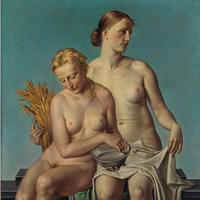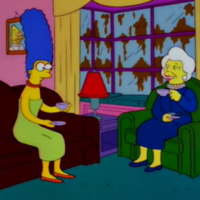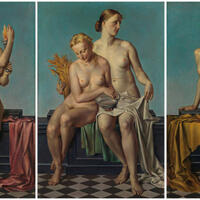More about Adolf Ziegler
Works by Adolf Ziegler

Contributor
We’ve all learned about the Nazi reign and the atrocities committed by them; while they were busy destroying Europe, though, Hitler also made sure to get his paws all over the culture of Nazi-controlled countries.
One of the main prerogatives of the Third Reich was to create a formula and an aesthetic policy for what art would look like in the new world order. Any work that received the Nazi stamp of approval would often be collected by the higher-ups of the party to show their stature: the bigger the collection, the higher the rank. Naturally, Hitler had the biggest collection out of the entire Nazi party which he’d cultivated for the planned future Führermuseum in Linz, Austria.
Collecting art for the Führermuseum was it’s own job, a job which Hitler labeled “Sonderauftrag Linz” or “Special Operation Linz." Sonderauftrag Linz sat in the lap of Joseph Goebbel, the Nazi Propaganda Minister. In June of 1937, Goebbel assigned Adolf Ziegler the task of whittling down the works for the Führermuseum.
Adolf Ziegler was Adolf Hitler’s favorite artist and president of the Reich Chamber of Fine Arts. Ziegler even painted a work called The Four Elements that Hitler hung above the fireplace in his personal home. Aside from being the centerpiece of the Fuhrer’s house, though, Ziegler is not particularly notable as an artist. He wasn’t a bad artist by any means, you could even describe his style as meticulously perfect. In his art, Ziegler did everything he could to fit the Third Reich’s formula of perfection while incorporating the Nordic nudes that Hitler loved. His only drawback was that he never pushed any kind of envelope.
The task that Goebbel assigned to Ziegler was to go to all of the museums in Nazi-occupied zones and confiscate any and all works that did not align with the Third Reich’s formula for aesthetic beauty. Ziegler collected hundreds of pieces of “degenerate art” including works by Emil Nolde, Kathe Kollwitz, Ernst Barlach, Kandinsky, Marc Chagall, and Pablo Picasso. Basically, any work of art made by a Jew or post-1910 was considered “undesirable.” So much work was collected that the Nazis were able to put on the Degenerate Art exhibition in July of 1937. It was meant to mock the artists in the show, to show how irrelevant these works really were, but the show ended up drawing a crowd estimated to be two million people strong.
In an unexpected turn of events, the Nazi actually sold some of the works at the exhibition and several more after the exhibition ended. Inspired, Ziegler was sent out to seize another 19,500 works and throw another degenerate art show. Any works deemed of value, the Nazi sold to the highest bidder to fund their military ventures. The works that didn’t sell were sent away to be destroyed in a massive bonfire outside of the Old Fire Station in Berlin…or were they?
Sources
- Lindsay, Ivan. The History of Loot and Stolen Art : From Antiquity Until the Present Day. London: Andrews UK, 2014. eBook Collection (EBSCOhost), EBSCOhost (accessed May 31, 2017).
- Späth, Daniela. "Conspiracies swirl in 1939 Nazi art burning | Culture | DW | 20.03.2014." Deutsche Welle.com. March 20, 2014. Accessed May 24, 2017. http://www.dw.com/en/conspiracies-swirl-in-1939-nazi-art-burning/a-1751….
- Sooke, Alastair. "Degenerate art: The art the Nazis hated." BBC. March 06, 2014. Accessed May 24, 2017. http://www.bbc.com/culture/story/20140306-the-art-the-nazis-hated.

Contributor
Born October 16, 1892 - Died September 18, 1959
Specialized in realistic nudes.
Was known among his fellow artists as "master of pubic hair".
Hitler loved him and hung his paintings in his home in Munich and in his mountain retreat.
Wore many hats, artist, politician, exhibition organizer, judge (of art).
He organized the infamous "Degenerate Art" exhibition to help educate people about the art that Hitler did not like.
Featured Content
Here is what Wikipedia says about Adolf Ziegler

Adolf Ziegler (16 October 1892 – 11 September 1959) was a German painter and politician. He was tasked by the Nazi Party to oversee the purging of what the Party described as "degenerate art", by most of the German modernist artists. He was Hitler's favourite painter. He was born in Bremen and died in Varnhalt, today Baden-Baden.
Check out the full Wikipedia article about Adolf Ziegler















